Revista Electrónica de Investigación Educativa
Vol. 7, No. 2, 2005
Mediational Competencies
for Online Education
María Elena Chan Núñez
machan@cencar.udg.mx
Coordinación de Investigación
Sistema de Universidad Virtual
Universidad de Guadalajara
Escuela Militar de Aviación 16
Col. Ladrón de Guevara, 44170
Guadalajara, Jalisco, México
Abstract
Addressed in the article is a position taken within and in favor of education and virtuality, considering the importance of training constructors of the digital environment. The competencies needed by actors of educational processes, the same which are necessary for their construction, are conceptualized as mediational. Because these are not usually the competencies most visibly when teachers and students are trained for online education, we found it of interest to present part of a research project on this type of competencies. The work starts out from an axiological position on virtual education, the recognition of the way the technologies model educational interactions on line. It follows with the notion of mediation and meditational competency, and comes to a design model that would consider these competencies in the development of learning environments. The article closes with reflections about the interdisciplinary integration necessary for a technological and educational development based on a communicative paradigm.
Key words: Virtual education, mediation, educational design, digital environments, on-line learning, educational communication.
Sometimes I leave my world and head for the larger spaces. I travel along paths nearly empty. But he passages I wander are not fixed. Along their limits shine processes, information flows like water on a damp wall, schools of information swim curiously around me, and grids of reality and fiction are scrambled unscrambled. Those who come to play unfold in the form of texts, images and locations (Novak, 1997).
Introduction
In the digital environment are materialized ideas, emotions, relationships. These are expressed by means of various types of digital objects, modes of permanent and temporary existence, not only of individuals but also of collectives, cultures, races. There are represented nationalities, genders, ages, ideologies. The digital environment is not a reflection of society, but is a space for social interaction, socially constructed, real and tangible.
From this position, the premise of this article submits:
The relationship between information technology and that of communication with education can not only be read from the perspective of technology as a tool or media support for education, but also the inverse relationship can be seen as education for communication and information with technological support. That is, the importance of the third environment, the digital, as a social space requires builders, actors—not just surfers, observers or readers who consume what others produce, however much information processing capabilities increase.
The development of new competences allowing subjects to relate with objects of knowledge in digital environments is perceived as part of a phenomenon of transformation of social practices—among them, practices of education, by the incorporation of what we call new technologies of information and communication.
What kind of competencies are we talking about? Do they have to do with new cognitive competencies? Or perhaps new communication competencies? Special didactic competencies in educators? About all these collectively?
Digital-environment construction competencies, which we will call mediational, are the subject of this article, which has been structured considering the following items:
- The digital world as a living environment, and reading material about the context.
- Structural mediation of technologies concerning the production of knowledge.
- Mediation and mediational competency.
- A mediational model for instructional design in digital environments.
- Challenges for interdisciplinarity.
1. The digital world as a living environment, and reading material about the context.
In this work, we will understand by virtualization, the process of creating an artificial world through a computer system, where the user has the impression of being in that world, being able to navigate through it and manipulate the objects in it (Echeverría, 2000). It is important to emphasize that virtuality is not considered as being opposed to reality, since it is always in reference to reality, and reality is contained in the virtual.
Augmented reality, according to Echeverria (2000), becomes a living space, following the natural and social environments in order; hence its designation as the third environment. It will give real practices, real feelings, real interactions. The notion of environment has for this author the connotation of space for interaction.
The third environment has represented a qualitative leap of enormous proportions that has completely changed perceptions of the time and space of the first two environments.
However, specifically in the field of education, virtual has been understood as an adjective describing the type of organization embodied in media support. That is, it has been used as a synonym for digitization of content, and the use of platforms and software as devices for educational action. This way of understanding virtual education reduces virtuality to support and permits no other possible meaning such as the orientation of education towards virtuality, or training for that other space of social life.
As an example of the implications of constructing the digital environment, we can analyze Figure 1, which expresses the proportion of languages to be found online:
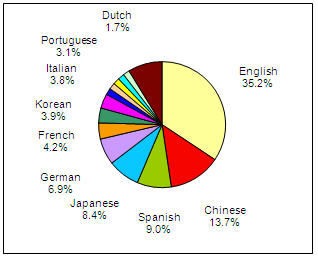
Figure 1. Population by languages on line
(total: 801.4 million in September, 2004).1
The disparity in the language representation suggests that the contents of certain cultures are underrepresented or are absent. Just as we use the language parameter, we could recognize any other category to compare proportions: nationality, disciplinary or scientific fields. This would allow us to see where the contents that circulate more are being placed and who is placing them, and how much representation there is for cultural diversity, for the problems and interests of groups, and for treating global issues.
Among the visible challenges to an education for life in the digital environment, the following can be found:
- Cultural heritage in the digital environment: the digital environment is becoming a major provider and distributor of cultural heritage, a way of preserving and positioning it.
- Modeling social interactions: social networks knitted together by the younger generations are shaping digital space, into their rhythm, their language and their themes.
- Professional competencies: more and more the professions are working in digital environments or with digital tools. A high proportion of professional knowledge and practice requires a mastery of digital environments and tools.
- Global view of knowledge: the possibility of forming groups and the location of international agendas enables the informative processing of knowledge from a global perspective.
- Multiculturalism: never before has there existed the potential for access to cultural content, so diverse and so rich in expression through the use of multiple languages embodied in the digital environment.
For these among other reasons, education for virtuality is a necessity which nonetheless faces some problems for its full expansion. Here are some reductionist views that may or may not resist it or stand in its way:
- The concept of educational internationalization: institutions of higher learning tend to see the digital environment with a view to expanding the market for educational services. Thus, the world is divided between those who sell and those who consume, and parameters of internationalization are considered to be covered equally, whether it has been possible to place the product in other countries, or if they have contracts to open local branches for foreign programs. Thus, the vision regarding the possibilities of the virtual university is partialized, given that there is no awareness of the potential for the creation of networks of global knowledge, nor for the (digital) conservation and diffusion of cultural patrimony. The investment and organization of the virtual is thus charged with the teaching load, to cover an ever-increasing number of “clients” regardless of the quality of those products developed for mass consumption.
- Use of technologies first and foremost for access to information: Another of the main problems is that which departs from the understanding of the digital revolution in all aspects of its social and cultural impact, to reduce technological use to the accessing of information. Many institutions base their policies on equipment and training to make information accessible to people, rather than on enhancing communication and tools of expression. Users have access to machines and browsers, but not to the programs for authoring software.
- Administrative and technical competencies focused on educational technology: there is also a reduction in terms of what is meant by the competency necessary for using technology in education. It is considered that the required core-knowledge elements are planning strategies, management of content and activities, and the effective management of all support possibilities—but communication skills are neglected.
- The platform design is drawn up considering processes of administration and control: the development of devices tends to facilitate the administration and monitoring of school processes, but very little is designed in consideration of modes of interaction, the meaning and expression required for different educational models. These administration platforms end up imposing their structure on educational relationships.
Thus we may close this section with some questions: what role must educational institutions take in facing the digital revolution? What dimensions of the digital revolution are now visible for educational institutions? Is the production of knowledge being considered in institutions as part of a positioning and occupying of spaces in this digital society? Is the school assuming the role of a builder in the digital environment?
Such questions can be assumed in a type of investigation that retrieves the technical as a category in educational research, and particularly the research done on the field of virtual education. But what does it mean to retrieve the technical as a category?
It means considering technology as a modeler of relationships, of modes of expression; as a facilitator of languages and spaces, and in turn, shapeable by the construction visions of the social, specifically of the educational.
In pedagogic discourse it is common to find the assertion that technologies are only tools or means. This view diminishes them, and places them in a field of apparent subordination to educational purposes. Also, computers and their resources are usually observed as artifacts about which research is done, considering the relationship between man and machine in its didactic possibilities, not addressing everything that circulates on the network and through the use of software programs, as the real social space of learning.
The position assumed in this article endeavors to show that this way of denying the other dimensions of communication outside mere media, nullifies the ability to calibrate the weight of technological use in cultural transformations.
The typical discourse about what should go before (the pedagogical) and what should go after (the technological) denies, in a way, the technological mediation that can transform even the sense of purpose; the selection of contents and the form they take; the time devoted to activities and the way these are done. Moreover, considering the effect of technology as a basis for reflection on the educational-virtual aspect which exceeds the dichotomous limitations imposed for investigating the pedagogical as separate from the technological, it is essential to obtain a thorough understanding of the social significance of the digital revolution.
2. Structural mediation of technologies concerning the production of knowledge
Structural mediation of knowledge technology covers economic, cultural, social and political macrodimensions. Limiting the observation of mediation to an intermediate level, addressed here is that related to which digital environments should be provided or structurally facilitated for the actions of knowledge.
Among the types of discourse over the education-technology relationship2 is what I will call the mediatic reductionist. This discourse subordinates technology to teaching, without perceiving the modeling of the former on educational practice; and is contradictory because the two types of discourse usually coexist in the expression of the same subjects. That is, it confers on technology an almost magical role ending in:
- Knowledge Networks.
- Collaborative learning.
- Learning Communities.
- Self-management by students.
I want to draw attention to this paradox: many educators who think of technology as subject to pedagogy use in their discourse concepts such as the ones mentioned above. They consider it possible, or always a given, based on a technologically-mediated education. Thus, these concepts are often cited, and become unquestionable elements of the knowledge accumulated in the field of distance education and learning technologies.
On the other hand, people talk about of the possibilities of online education as naturally related to collaborative learning, learning communities, the achievement of self-management. Thus, the media are associated with qualities of educational practices as if they were cause and effect: knowledge networks, collaborative learning, etc., are considered to be naturally derived from the use of certain types of technological support.
Asking this question would imply asking as well: are online learning communities formed in all online courses? Is collaborative learning apparent in the forums of online courses? Is the knowledge network guaranteed by the provision of a platform and tools for information exchange? Is self-management achieved by the fact that a student follows on his/her own, a set of activity instructions, or even choose his or her own set of activities and products to turn out?
The risk of taking these questions for granted is that this move will bring about a shift in educational research; i.e. they are neither approached as a problem, nor addressed as an object of study, but become part of rhetorical expressions in spite of their lack, in many cases, of empirical reference.
However, to explore these notions more deeply and grasp them methodologically for observation in digital environments, it is necessary to begin with some considerations about the structural mediation of technology based on ways of knowing. Any type of technology from prehistory to the present day has mediated human ways of knowing.
Gordon Wells (2001), in attempting to clarify the nature of knowledge, and in his eagerness to argue the dialogic nature that education should have, recognizes six ways of knowing, adopting a cultural-historical perspective to describe their appearance according to different manners of participation in human activity. He argues that this activity is always mediated by artifacts of various kinds, and that knowledge is associated with the creation and use of them.
He calls the first four modes of knowledge instrumental, procedural, substantive and esthetic. The last three are dependent on social interaction. These occurred before literacy, and belong to the social-material world inhabited by a cultural group, constructed largely by participation in group activities and through face-to-face interaction.
The fifth way of knowing, the theoretical, emerged from the diversification of activity and the more-pronounced division of labor. With the emergence of a hierarchy of classes or castes freed from direct involvement in material production, the privileged class became interested in researching and synthesizing the procedural, substantive, and aesthetic knowledge created in other activity systems. The intended result was to systematize and improve this knowledge, now treated as a separate object. Writing as technology facilitated the development of such knowledge.
The sixth mode is metacognition, of very recent origin, at least in its linguistic genealogy.
From this perspective, only the instrumental mode assumes contact with objects and physical tools, while the others are conceptual and interactive in nature. We can assume, then, that in a digital setting it is possible to know, because it is possible to interact, and that the relationship with the objects of knowledge is mediated, since they can be conveyed to the subject through various channels of representation.
From the perspective of Wells (2001), except for the first mode of knowing, which involves direct manipulation of tools and the transformation of materials, the procedural moves—substantive, aesthetic, theoretical and metatheoretical—have a communicative nature. And it is this kind of communication, precisely, which makes feasible their management in digital environments.
On the other hand, we return to what Morin (1988) identifies as the three faces of Kant’s philosophy:
- The things themselves cannot be grasped, but only the elements.
- It is our mental structures that allow us to know something.
- Therefore, these structures of knowledge are a privileged object: if we cannot know external reality as such, we can at least know a primary interior reality. We can know the organization of our knowledge.
To illustrate this idea better, I present Table I.
Table I. Processes and objects of knowledge3
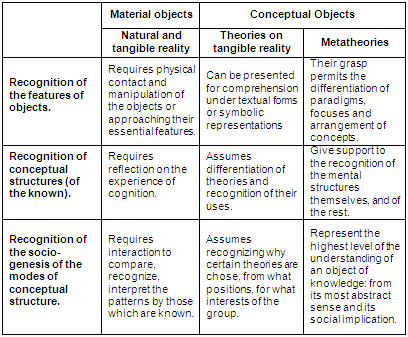
How can this picture be interpreted in the context of virtual education?
Of the nine areas of the matrix, only one, the first on the left above, requires the representation of objects and their manipulation. The other eight processes require exercises in which interaction is the foundation for achieving knowledge.
Therefore, the central concern when designing courses in digital environments, from this perspective, would concern how to make the subject recognize his or her own thinking and that of others, as well as the social genesis of the ways people think.
Then knowing, as a process, takes much more than the presentation of informative content. Over the same matrix we can imagine a diagonal axis that would point out the depth of knowledge (see Table II).
Table II. Trajectory in deepening knowledge
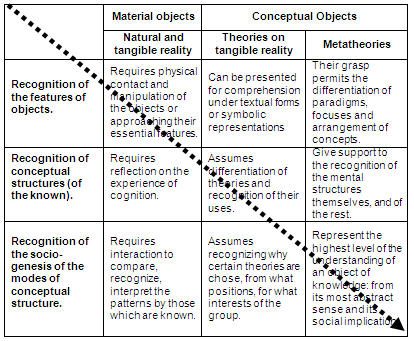
This constructivist mode of approaching knowing meets no resistance in the digital environment. On the contrary, because interaction is the essential aspect of the digital environment—according to Echeverría (2000)—it is dialogicity that is its instrument and subject.
But we would have to consider that this dialogicity has the potential, since it always depends on how the conditions in the environment itself are offered so as to enable it. The design of the environment is what provides conditions, guidelines and models for interaction.
The best-known platforms for the implementation of online education have a common and easily-recognizable organizational structure: spaces for collections of information and the instruction of activities, forums to promote interaction, agenda; space for evaluation, monitoring and control, among others.
These elements allow the organization of teaching and learning strategies, and are open enough to contain any educational model.
At least apparently, any type of strategy can fit. But should we express the array of objects and ways of knowing as a design parameter, we might imagine any other arrangement of the interface and consider another type of areas:
- the area of initial contact with the objects of knowledge;
- that of recognition of personal conceptual structuring;
- that of comparing the meanings of self with that of others and the construction of the collective schematic.
That is, we can observe the technological mediation in the case of online course design when we consider how we educators have come to think and convince ourselves that the interface must have such and such elements. We use the device as it is, and we do not necessarily recognize that it can be adapted to other models.
3. Mediation and mediational competency
The necessity for a focus based on the analysis of mediation is felt when the management of information, acts, subjects, are manifested as an activity which cannot be dissociated nor analyzed in parts (Martín Serrano, 1994).
The notion of mediational competency begins by considering that this is a type within the area of mediations, in their broadest sense, and by recognizing it as an ability to perform tasks of communicative character, articulated between processes of different nature (see Figure 2):
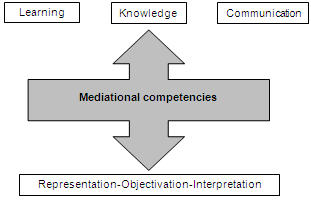
Figure 2. Mediational competencies
Thus, meditational competencies have a liaison function between:
- Reality-Virtuality;
- Real object - Media object;
- Meaning of the object - meaning of networks of objects;
- Meaning expected in the design - meaning resulting in the student;
- Real objects, natural and social - real digital objects;
- Personal meaning - collective meaning;
- Expected meaning - resulting meaning.
The space of execution or performance setting of the mediational competency is the interface, understood as the space of mediated action. Mediational competency is embodied in carrying out tasks of varying complexity, to the extent that they are repeated as stable patterns within a social practice such as education, and can be constituted in structuring functions of the way of learning, and consequently as the way of knowing (Chan, 2004).
Based on the research conducted, concerning the mediational competencies in the executions of students and teachers in the digital environment (Innova, U. de G., 2002-2004), Table III presents the type of mediational tasks that could be grouped into four dimensions:
Table III. Four mediational tasks
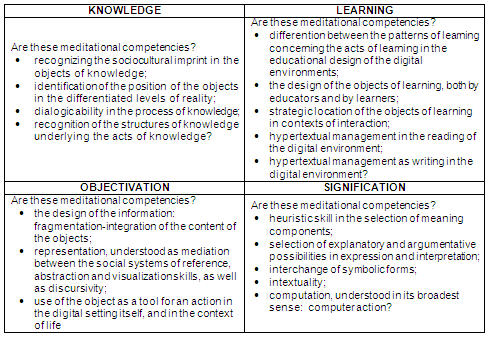
The questions contained in the boxes come from a communicative posture with reference to knowledge, learning and meaning. While each quadrant and each question could refer to epistemic, cognitive, and communicative competencies, now recognized as such in diverse disciplinary contexts, what we are attempting to show is the vision as a whole.
Mediational competencies required to design and operate in a digital environment may manifest themselves articulately, and can be approached in the same way so as to be developed deliberately.
4. A mediational model for instructional design in digital environments
In order to model the digital environment and adapt it to the ways of interaction and learning required by individuals and groups, there are required skills that go far beyond the administrative and organizational activities in pre-established supports.
The wealth of interaction, and consequently, of the quality of learning, depends on the ability and experience of those interacting. In order to capture objects of knowledge for teaching or as products of learning, or to represent these by the use of the multiplicity of languages possible in the digital environment, there is required a process of grasping the essential features of the real object.
Figure 3 shows a process of objectification or mediation from a real object to its media representation:
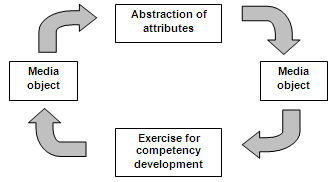
Figure 3. Basic model for the design of the object
Virtuality is constructed under the consideration that those who complete the experience of the digital environment are the interpreters. Hence the importance of the mediational competencies both in those who produce representations of objects of knowledge, and in those who interpret them. Educators and students play these two roles alternately in a dialogic process. In that sense, virtuality is at least triadic (see Figure 4).
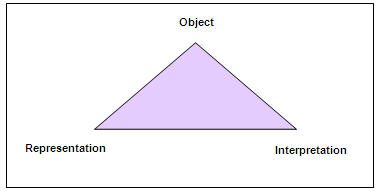
Figure 4. Three elements of virtuality
Items placed as content of the digital space are the result of an act of representation and are open to interpretation. What completes them as objects is that representation-interpretation-signification cycle.
These three mediational competencies are not visible in the way competencies are ordinarily expressed for educators and learners. Usually, training for virtual education is limited to mastering the platform’s functions and managing them properly. Commonly seen as the educator’s competencies:
- Managing stimulating virtual environments;
- Promoting collaborative learning;
- Designing educational material;
- Group management;
- Producing texts.
But there is no specific training given on the how(s); for example: how to manage a challenging virtual environment; how to promote collaborative learning.
The competencies which would underlie such actions are precisely those called mediational: representation, interpretation and signification, which would be generic or basic, common to different tasks of authoring courses and implementing them. It would be worthwhile to focus on them as substrata for these other, more specific competencies.
Figure 5 shows a kind of metaphor: the web page, as the uppermost surface of the interface, put into perspective as a cube in which there is a deep level, woven hypertextually using chains of meaning, and a superficial level in which we see the spaces organized with a particular structure and iconography.
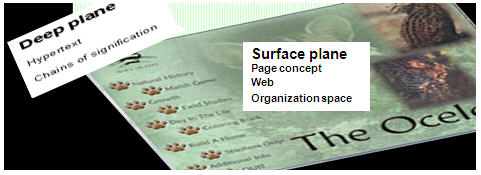
Figure 5. Interface planes: surface and in-depth
The layers invisible to a navigator are those on the deep plane. Let’s say then that when we look at the interface of an online course on the screen, we are seeing only the visible face of a cube that contains many actions and interactions at the back, those in which are found the learning processes, the communicative acts. These layers are completely knit together with digital objects sent by the actors.
Frames of meaning can be traced in the forums, and in any space that supports viewing footage of production-feedback. If the structure of the environment does not allow seeing the frames, they are hidden from everyone, or are visible only to those who deliberately seek them, but are not obviously available.
Put another way, the design of an online course does not end with the visible instructional and interface configuration, but unfolds in the exercises of all the actors who move in the design, seen as a dynamic stage.
What have we found in observing these frameworks of meaning in the research mentioned earlier?
Since the intention of a methodology is to observe objects of meaning produced by students, and the sequence of their messages (meanings), we were able to observe the way in which the learning objects proposed as content for a course are appropriate and enriching. It could also be recognized that the mediating tasks performed were:
- Students read information about objects contained.
- Some used the information in producing objects according to the request of the authors of the courses.
- The production of the students’ objects assumed selecting information contained in the references, locations or posts in connection with references from personal experience.
- No operation was performed with the new objects produced; even in the forum space there was limited contact with the objects.
- Information was interpreted in a restricted fashion. The standard for interpretation was personal experience, knowledge or belief, without finding the instruction that could lead to other levels of interpretation, and therefore, to a recognition of the student’s own conceptual schematic organized regarding the object.
- However, there was more activity around interpretation than around representation.
- Actions tending toward representation used sparingly the information contained in the courses as a foundational element for a construction.
- The activity of representation activity seemed restricted to the action of “transfer” from an area in the interface—that of the contents, reading or input—to that of products.
- The activity of representation seemed to be centered on the reduction of information, as opposed to abstraction as selective mediation of objects’ essential features.
In answer to questions about what type of modeling skills were observed through the use of platforms or tools, or whether it was possible to observe a modeling of competencies, we can say that:
- some individuals have a greater ability to contextualize their messages or products, so as to structure them according to the guidelines, to situate their discourse production around the essential features of objects, to interpret what others pose, and above all, to question and respond;
- these differences suggest that people could be treated with different sorts of training for self-management and for interaction online.
The triadic methodology (representation, interpretation, significance) permitted these to be included in the observation.
- Competency understood as implementation. That is, it is not about each person’s capabilities, but about the correlation of these capabilities as evidenced in the production of meaning in a group.
- The actual production (of digital objects) with which the composition of a digital environment begins and ends as a space for individual and collective practices.
- The processes of signification, understood as communicative production of some sort, through which the tracking of the chain of products allows us to understand processes which could remain hidden if the entities produced were taken as a source of observation, and not the interpretations contained in their objectification.
The application of discursive and semiotic analysis which was applied to the investigation may be an axis for the design of graphical tools that would give way to other types of interfaces. Graphical tools contained in virtual environments can help educators and students to be aware of their own paths of meaning and of what is collectively produced.
5. Challenges for interdisciplinarity
What kind of interface design can best support the visualization and organization of the sense, can provide the spaces and tools for representation and interpretation? This question is intended to indicate the type of challenges that can be seen in relation to the mediational competencies.
On the one hand, it concerns the type of training required for actors in virtual-learning environments, which should consider mediational competencies as generic. This type of training needs to be experiential and practical if one takes into account that it is possible to learn to represent, interpret and express meaning, since these are not innate abilities, but can be developed. On the other hand, considering the mediational competencies for the fabric of meaning and knowledge in digital environments requires a design of spaces that facilitate and make visible the tasks of representation, interpretation and signification.
Since content-management tools are increasingly available to teachers, without their having to be experts in either pedagogy or technology, would it be possible to have semiotic tools in the interface, for those who are not experts in semiotics?
In order to make the interface a space for communication in education, it would have to provide the equipment, programs and languages needed for building the spaces, rather than having people take for granted that the spaces would already exist. If the essence of the digital environment is interaction (the expression of its ways and results), the objects produced in it, together with their trajectories would have to be arranged in so obvious a way as to be components of the interface, and there facilitate such visualization of the levels of comprehension and structuring of individual and collective knowledge. For this to happen, there must be a strong team effort between professionals of different disciplines: communicators; specialists in discourse analysis; specialists in semantics and semiotics; anthropologists; sociologists; psychologists. That is, the virtual educational space requires much more than just pedagogical and technological knowledge.
What one would expect from a virtual learning environment is that it would provide such conditions for the production of a mutual sense which the objects (of learning produced by the learners) ought to transcend or spill into other areas of daily life in natural, social-urban, and of course, digital environments. Developing the ability of all users and authors is the goal of a communicative education.
From another perspective, the best virtual-learning environment is that leaves teachers and learners more open spaces for construction.
The mediational competencies are modeled by the institutionalization of information and communication technologies, are constituted in mediation of content, its forms of expression and the transformation processes of such content. Hence, the importance of forming multidisciplinary teams who would provide ever-improved virtual spaces for learning. It has to do with moving toward a communicative-educational design theory, oriented toward the interface as a privileged space for mediation, not centered exclusively on teaching efficacy, but on the possibility of communication: the generator of meaning.
References
Colom, A. (2002). La (de)construcción del conocimiento pedagógico. Nuevas perspectivas en teoría de la educación. Buenos Aires: Paidós.
Chan, M. E. (2004). Modelo mediacional para el diseño educativo en entornos digitales. Mexico: Innova, Universidad de Guadalajara.
Echeverría, J. (2000). Un mundo virtual. Barcelona: Plaza & Janés.
Martín Serrano, M. (1994). La producción social de comunicación. Madrid: Alianza Universidad.
Morin, E. (1988). El Método: El conocimiento del conocimiento. Madrid: Cátedra.
Novak, M. (September-Octuber, 1997). Arquitecturas líquidas en el ciberespacio. IPN Ciencia, Arte: Cultura. Retrieved August 13, 2004, from:
http://www.hemerodigital.unam.mx/ANUIES/ipn/arte_ciencia_cultura/sep-oct97/arquitec/arquitec.html
Wells, G. (2001). Indagación dialógica, hacia una teoría y una práctica socioculturales de la educación. Buenos Aires: Paidós.
Recommended bibliography
Ibarra Mendívil, J. L., Ortega, D. C., & Ortiz, A. (Coords.). (January 15, 2003). Estudio sobre el uso de las tecnologías de comunicación e información para la virtualización de la Educación Superior en México. Mexico: UNESCO, Instituto Internacional para la Educación Superior en América Latina-Asociación Nacional de Universidades e Instituciones de Educación Superior. Retrieved September 11, 2004, from: http://www.anuies.mx/principal/programas/estudios/pdf/vir_mx.pdf
Arriaga, J., Pastor, E., & Gaitán, J. J. (2002). Informe de evaluación de plataformas. Madrid: Universidad Politécnica de Madrid, Gabinete de Tele-Educación. Retrieved August 18, 2004, from: http://www.gate.upm.es/plataformas/herramientastele/index.htm
Bannan-Ritland, B, Dabbagh, N., & Murphey, K. (2002). Learning object systems as constructivist learning environments: Related assumptions, theories and applications. Retrieved August 23, 2004, from: http://reusability.org/read/chapters/bannan-ritland.doc
Bettetini, G. & Colombo, F. (1995). Tecnología y comunicación, de las nuevas tecnologías de la comunicación. Barcelona: Paidós.
Bonsiepe, G. (1998). Del objeto a la interfase. Mutaciones del Diseño. Buenos Aires: Ediciones Infinito.
Costa, J. (1998). La esquemática. Barcelona: Paidós.
Global Reach (March 30, 2004). Global internet statistics. Retrieved Octuber 28, 2005, from: http://global-reach.biz/globstats/index.php3
Gutiérrez Pérez, F. & Prieto, D. (1991). La mediación pedagógica. Apuntes para una educación a distancia alternativa. San José de Costa Rica: Radio Nederland.
Halliday, M. A. K (1982). El lenguaje como semiótica social: la interpretación social del lenguaje y del significado (Trans. J. Ferreiro). Mexico: Fondo de Cultura Económica (Original work published 1978).
Hannafin, M., Land, S., & Oliver, K. (2000). Entornos de aprendizaje abiertos: fundamentos, métodos y modelos. In C. M. Reigeluth (Coord.), Diseño de la instrucción. Teorías y modelos (Part I, pp. 125-152). Madrid: Aula XXI, Santillana.
Jensen, K. (2002). Modelos comunicantes: la importancia de los modelos para la investigación sobre los mundos de la Internet (Trans. R. Fuentes Navarro).
Kaplún, M. (1992). Primer exploración: una pedagogía comunicante. In UNESCO-Oficina Regional de Educación para América Latina y el Caribe, A la educación por la comunicación. La práctica de la comunicación educativa (pp. 19-62). Santiago de Chile: UNESCO-Oficina Regional de Educación para América Latina y el Caribe.
Martín Barbero, J. (1987). De los medios a las mediaciones. Mexico: Gustavo Gilli.
Martín, F. (2002). Contribuciones para una antropología del diseño. Barcelona: Gedisa.
Marqués Graell, P. (1999). La investigación en tecnología educativa. Retrieved April 14, 2004, from: http://dewey.uab.es/pmarques/uabinvte.htm
Merrill, D. (2000). Teoría de la transacción educativa (TTE): Diseño educativo basado en objetos de conocimiento. In C. M. Reigeluth (Coord.), Diseño de la instrucción. Teorías y modelos (Part I, pp. 449-479). Madrid: Aula XXI, Santillana.
Piaget, J. & García, R. (1989). Hacia una lógica de significaciones. Lógica-Epistemología. Mexico: Gedisa.
Potter, J. (1998). La representación de la realidad. Discurso, retórica y construcción social. Barcelona: Paidós.
Prieto, D. (1999). El juego del discurso. Buenos Aires: Lumen.
Reigeluth, C. (2000). Diseño de la Instrucción Teorías y modelos. Un nuevo paradigma de la teoría de la instrucción (Part I & Part II). Madrid: Aula XXI, Santillana.
Rheaume, J. & Laferriere, T. (May, 2000). Analyse sémiologique d’activités pédagogiques sur Internet. Cahier du français contemporain, 6, 175-195.
Tedesco, J. C. (2000). Educar en la sociedad del conocimiento. Mexico: Fondo de Cultura Económica.
Visser, J. (2002). Innovación: Necesidad científica y elección artística. Disponible en el sitio web de Cátedras de Innovación Educativa, Universidad de Guadalajara Retrieved September 12, 2005, from: http://www.learndev.org/dl/Innovacion-UdG-2002.pdf
Translator: Lessie Evona York-Weatherman
UABC Mexicali
1This graphic was originally published by Global Reach (2004). On it appear only the languages with the greatest proportion of speakers in the world. It can be seen that the smaller portions taken together mean other languages, but these are not specified.
2The analysis of the discourse to which we refer approached works was presented in various events organized by such bodies as Innova, University of Guadalajara, the Mexican Council of Educational Research, the Mexican Society of Computer Education, and the Latin American Institute for Educational Communication (ILCE, its Spanish acronym), between 1994 and 2004. The methodology of processing and its results is in the process of publication in an edition of Virtual University System at the University of Guadalajara, for December, 2005.
3The axes of the matrix have been reintroduced: the horizontal areas of Karl Popper’s reality from the perspective of Colom (2002), who takes them up to answer the question, “Can you communicate reality?” In the vertical axis the three faces of Kant’s philosophy integrate into the third, a sociogenetic vision of knowledge, considering that it is in interaction with others that we recognize not only our own structures, but their social and cultural origin.
Please cite the source as:
Chan, M. E. (2005). Mediational competencies for online education. Revista Electrónica de Investigación Educativa, 7 (2). Retrieved month day, year, from:
http://redie.ens.uabc.mx/vol3no1/contents-chan.html







